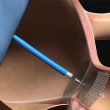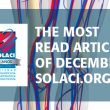After four years of follow-up, the PRAGUE-17 study showed that appendage closure is non-inferior to direct anticoagulant agents (non-warfarin oral anticoagulants, NOAC) to prevent major neurological events, cardiovascular events, and bleeding events in patients at high risk of atrial fibrillation. Appendage studies were compared with warfarin studies—it was necessary to update anticoagulant agents and reach<a href="https://solaci.org/en/2021/12/14/prague-17-appendage-closure-vs-direct-anticoagulant-agents/" title="Read more" >...</a>
Atrial Fibrillation and Dementia: Which Anticoagulant Agent Presents the Lowest Risk?
Atrial fibrillation is a risk factor for dementia and anticoagulant agents have been proven to decrease it. This work aims to find differences in the risk of dementia between patients treated with traditional choice warfarin vs. different direct anticoagulants. Between 2014 and 2017, this study enrolled 72,846 patients >40 years with nonvalvular atrial fibrillation who<a href="https://solaci.org/en/2021/11/09/atrial-fibrillation-and-dementia-which-anticoagulant-agent-presents-the-lowest-risk/" title="Read more" >...</a>
TAVR in Low-Risk Patients: Though still Superior, with Diminished Advantage after 2 Years.
At two-year followup, primary end point continued to be significantly lower with Sapien 3 vs. conventional surgery, but the initial difference in death and stroke in favor of TAVR started to shrink. In addition, there was higher risk of valve thrombosis in TAVR patients. The PARTNER 3 (Safety and Effectiveness of the SAPIEN 3 Transcatheter<a href="https://solaci.org/en/2021/03/16/tavr-in-low-risk-patients-though-still-superior-with-diminished-advantage-after-2-years/" title="Read more" >...</a>
AHA 2020 | Omega-3 Fatty Acids Provide No Cardiovascular Benefits and Cause More Atrial Fibrillation
Results confirm the interim analysis, whereby the study was suspended for futility. Omega-3 fatty acids do not reduce cardiovascular events in patients with high triglycerides and low HDL. Previous studies, such as REDUCE-IT, had shown positive results, but given this new research (presented at the American Heart Association [AHA] 2020 Congress and simultaneously published in<a href="https://solaci.org/en/2020/11/24/aha-2020-omega-3-fatty-acids-provide-no-cardiovascular-benefits-and-cause-more-atrial-fibrillation/" title="Read more" >...</a>
AHA 2020 | EMPATROPISM: Empagliflozin in Non-Diabetics with Cardiac Failure
Empagliflozin improves cardiac function, exercise capacity and quality of life in non-diabetic patients with cardiac failure and deteriorated ejection fraction. These findings were presented during the scientific sessions at AHA 2020 and published simultaneously in JACC. EMPATROPISM outcomes are on the same line as other studies using sodium glucose 2 cotransporter inhibitors (SGLT2) which showed<a href="https://solaci.org/en/2020/11/23/aha-2020-empatropism-empagliflozin-in-non-diabetics-with-cardiac-failure/" title="Read more" >...</a>
Is Loading NSTEMI with DAPT Convenient?
Pretreating non-ST elevation acute myocardial infarction (NSTEMI) patients with P2Y12 receptor inhibitors is not associated with improved clinical outcomes as it is to increased bleeding. NSTEMI patients are often treated with platelet antiaggregants in the daily clinical practice despite the lack of evidence for its benefits. This Swedish registry prospectively included 64857 patients undergoing NSTEMI<a href="https://solaci.org/en/2020/10/28/is-loading-nstemi-with-dapt-convenient/" title="Read more" >...</a>
Evidence or Theory? Antiaggregation Scheme after Peripheral Vascular Intervention
Antiaggregation indication after peripheral intervention (PVI) can vary up to 50% depending on center, operator, and procedure. This highlights the huge variation in indication and the scarce evidence there is on this matter. Most cardiologists would like to simply transfer the information from the coronaries to the superficial femoral, but we can confirm this does<a href="https://solaci.org/en/2020/09/15/evidence-or-theory-antiaggregation-scheme-after-peripheral-vascular-intervention/" title="Read more" >...</a>
The Most Read Articles of December in solaci.org
1- Consensus on How to Conduct Follow-Up in Peripheral Vascular Disease Peripheral vascular disease involves multiple areas and, therefore, can have very different presentations (from complete lack of symptoms to disabling symptoms). Depending on clinical presentation, general condition, anatomical localization, and lesion extension, revascularization can be indicated alongside optimal medical treatment. Read also HERE 2-<a href="https://solaci.org/en/2020/01/06/the-most-read-articles-of-december-in-solaci-org/" title="Read more" >...</a>
Benefit of Anticoagulation in the Elderly with Atrial Fibrillation
Guidelines recommend oral anticoagulation for all ≥ 75-year-old patients with atrial fibrillation. However, there is little evidence as to its net clinical benefit in the elderly population. This study looked at the life net clinical benefit in atrial fibrillation patients over 75 years of age treated with warfarin or apixaban vs. no treatment. Researchers observed<a href="https://solaci.org/en/2019/12/09/benefit-of-anticoagulation-in-the-elderly-with-atrial-fibrillation/" title="Read more" >...</a>
Net Benefit of Left Atrial Appendage Closure vs. Anticoagulation in Atrial Fibrillation
This analysis shows that the long-term clinical benefit of left atrial appendage closure with Watchman is superior to warfarin in patients with atrial fibrillation (AF). The initial peri-procedural risks of device implantation are counterbalanced over time, with reduced risk of bleeding and death. The PROTECT-AF (Watchman Left Atrial Appendage Closure Technology for Embolic Protection in<a href="https://solaci.org/en/2019/12/02/net-benefit-of-left-atrial-appendage-closure-vs-anticoagulation-in-atrial-fibrillation/" title="Read more" >...</a>








